Global Business Management Report: Globalization Impact Analysis
VerifiedAdded on 2022/11/09
|11
|2510
|360
Report
AI Summary
This report delves into the multifaceted aspects of global business management, commencing with an analysis of the primary drivers of globalization, such as technological advancements, improved transportation, and market liberalization. It then explores the Heckscher Ohlin model to assess comparative advantages and their influence on business viability, emphasizing the roles of labor costs and trade agreements. The report conducts a PESTLE analysis of Apple and Huawei, comparing their political, economic, social, technological, legal, and environmental challenges. It applies the Porter diamond model to evaluate national competitive advantages, focusing on factor conditions and home demand. Finally, it recommends concentric and horizontal diversification strategies for Apple and Huawei to enhance market share and address identified risks. The report covers strategic complexities, risks, diversification strategies, and organizational structure within a global context.
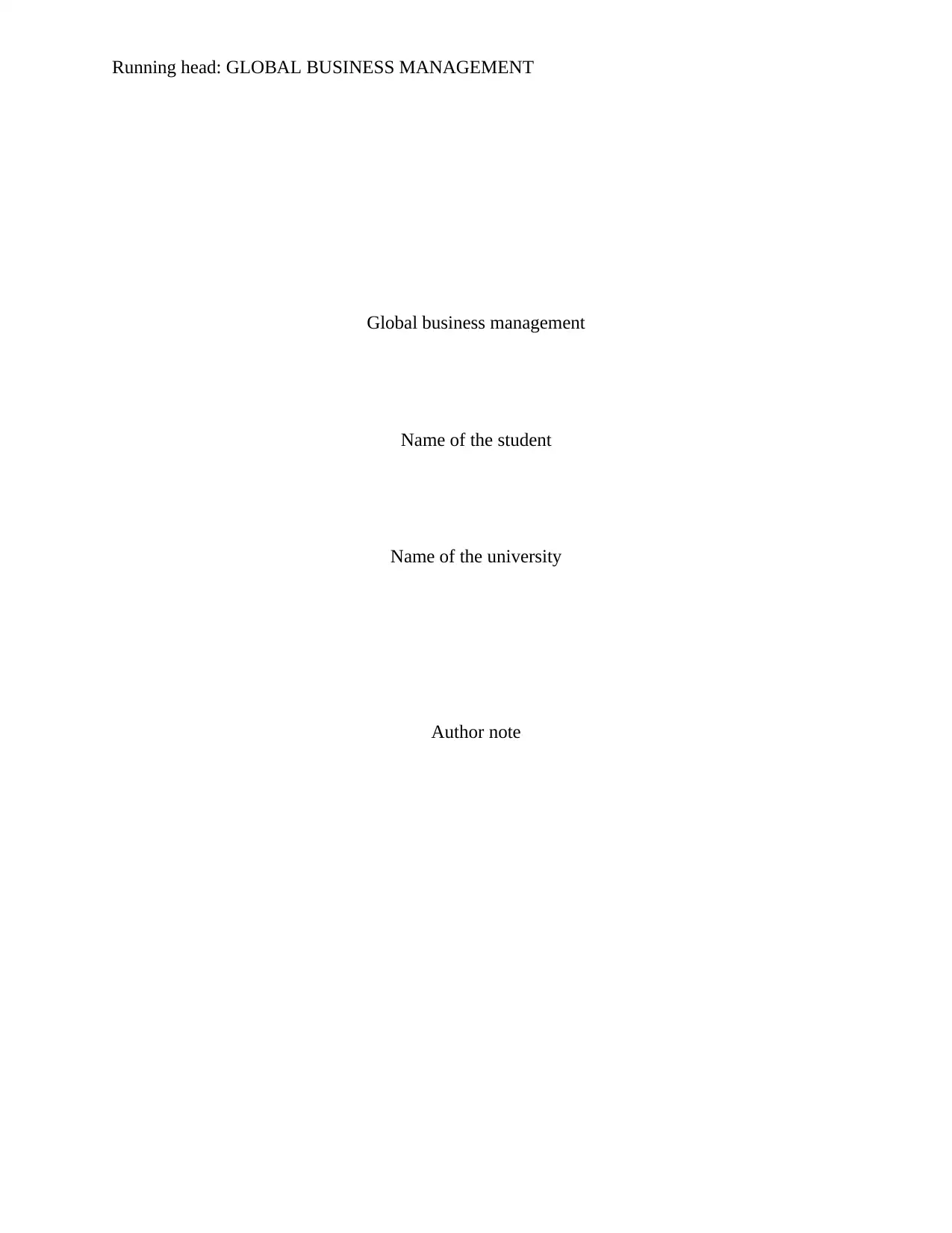
Running head: GLOBAL BUSINESS MANAGEMENT
Global business management
Name of the student
Name of the university
Author note
Global business management
Name of the student
Name of the university
Author note
Paraphrase This Document
Need a fresh take? Get an instant paraphrase of this document with our AI Paraphraser
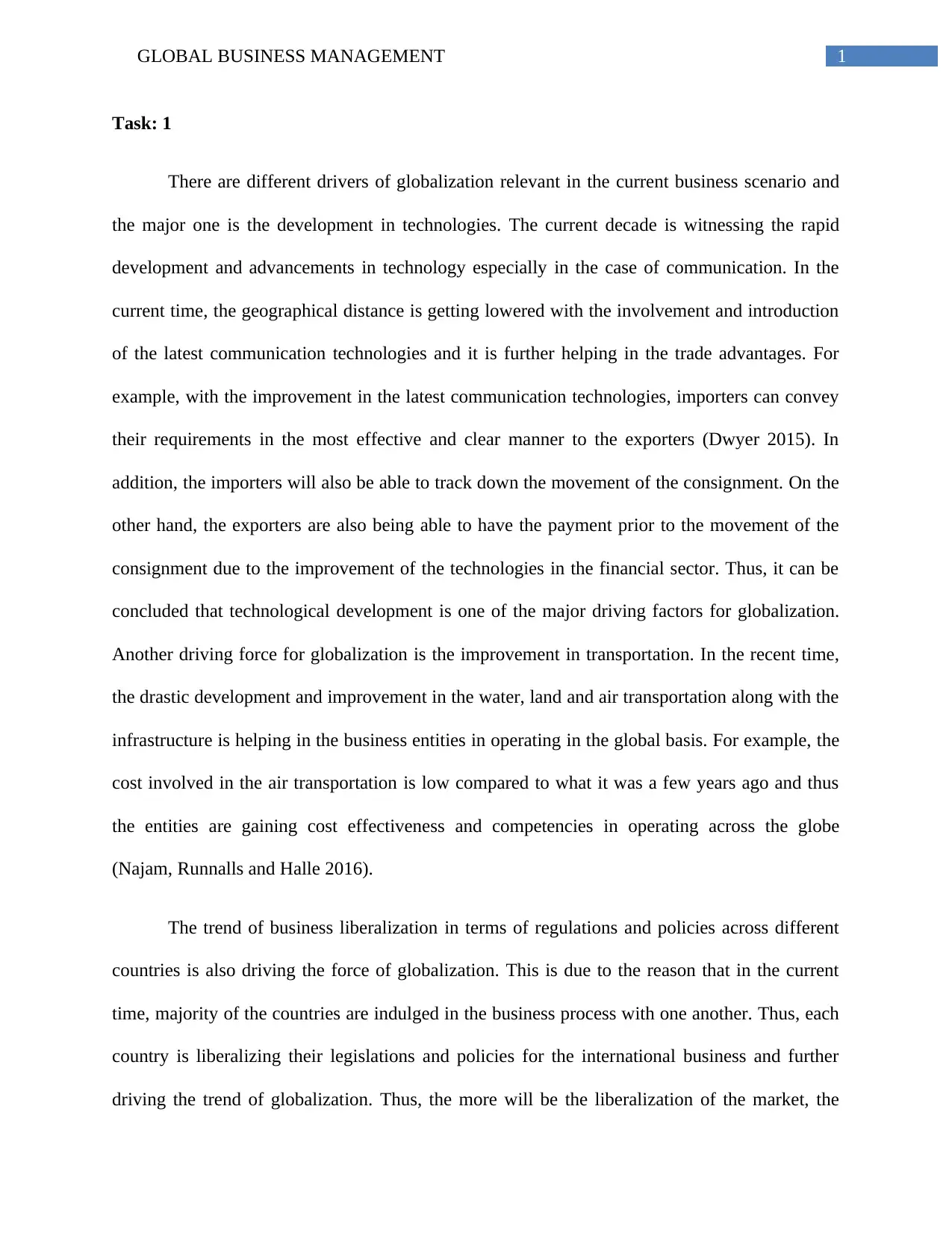
1GLOBAL BUSINESS MANAGEMENT
Task: 1
There are different drivers of globalization relevant in the current business scenario and
the major one is the development in technologies. The current decade is witnessing the rapid
development and advancements in technology especially in the case of communication. In the
current time, the geographical distance is getting lowered with the involvement and introduction
of the latest communication technologies and it is further helping in the trade advantages. For
example, with the improvement in the latest communication technologies, importers can convey
their requirements in the most effective and clear manner to the exporters (Dwyer 2015). In
addition, the importers will also be able to track down the movement of the consignment. On the
other hand, the exporters are also being able to have the payment prior to the movement of the
consignment due to the improvement of the technologies in the financial sector. Thus, it can be
concluded that technological development is one of the major driving factors for globalization.
Another driving force for globalization is the improvement in transportation. In the recent time,
the drastic development and improvement in the water, land and air transportation along with the
infrastructure is helping in the business entities in operating in the global basis. For example, the
cost involved in the air transportation is low compared to what it was a few years ago and thus
the entities are gaining cost effectiveness and competencies in operating across the globe
(Najam, Runnalls and Halle 2016).
The trend of business liberalization in terms of regulations and policies across different
countries is also driving the force of globalization. This is due to the reason that in the current
time, majority of the countries are indulged in the business process with one another. Thus, each
country is liberalizing their legislations and policies for the international business and further
driving the trend of globalization. Thus, the more will be the liberalization of the market, the
Task: 1
There are different drivers of globalization relevant in the current business scenario and
the major one is the development in technologies. The current decade is witnessing the rapid
development and advancements in technology especially in the case of communication. In the
current time, the geographical distance is getting lowered with the involvement and introduction
of the latest communication technologies and it is further helping in the trade advantages. For
example, with the improvement in the latest communication technologies, importers can convey
their requirements in the most effective and clear manner to the exporters (Dwyer 2015). In
addition, the importers will also be able to track down the movement of the consignment. On the
other hand, the exporters are also being able to have the payment prior to the movement of the
consignment due to the improvement of the technologies in the financial sector. Thus, it can be
concluded that technological development is one of the major driving factors for globalization.
Another driving force for globalization is the improvement in transportation. In the recent time,
the drastic development and improvement in the water, land and air transportation along with the
infrastructure is helping in the business entities in operating in the global basis. For example, the
cost involved in the air transportation is low compared to what it was a few years ago and thus
the entities are gaining cost effectiveness and competencies in operating across the globe
(Najam, Runnalls and Halle 2016).
The trend of business liberalization in terms of regulations and policies across different
countries is also driving the force of globalization. This is due to the reason that in the current
time, majority of the countries are indulged in the business process with one another. Thus, each
country is liberalizing their legislations and policies for the international business and further
driving the trend of globalization. Thus, the more will be the liberalization of the market, the
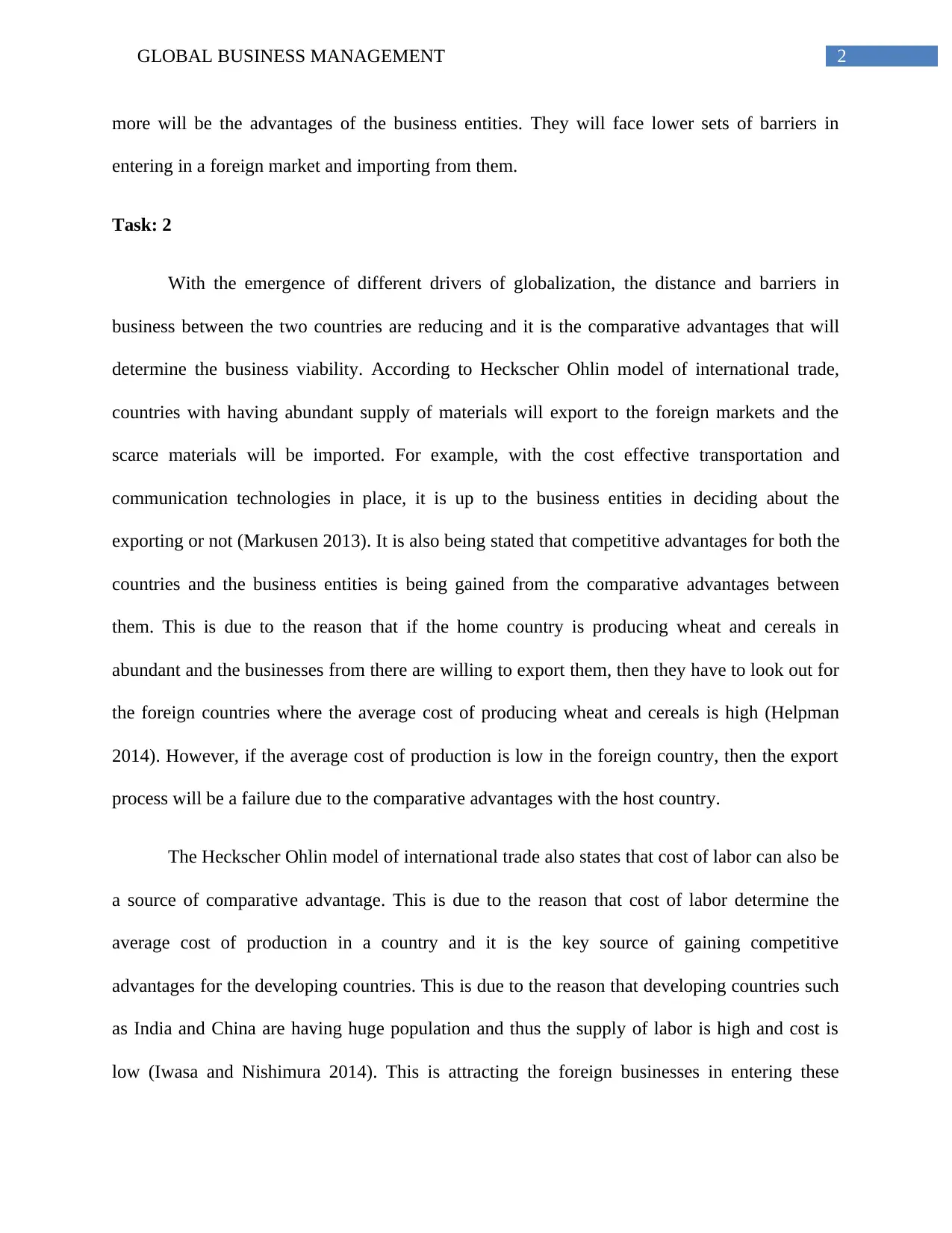
2GLOBAL BUSINESS MANAGEMENT
more will be the advantages of the business entities. They will face lower sets of barriers in
entering in a foreign market and importing from them.
Task: 2
With the emergence of different drivers of globalization, the distance and barriers in
business between the two countries are reducing and it is the comparative advantages that will
determine the business viability. According to Heckscher Ohlin model of international trade,
countries with having abundant supply of materials will export to the foreign markets and the
scarce materials will be imported. For example, with the cost effective transportation and
communication technologies in place, it is up to the business entities in deciding about the
exporting or not (Markusen 2013). It is also being stated that competitive advantages for both the
countries and the business entities is being gained from the comparative advantages between
them. This is due to the reason that if the home country is producing wheat and cereals in
abundant and the businesses from there are willing to export them, then they have to look out for
the foreign countries where the average cost of producing wheat and cereals is high (Helpman
2014). However, if the average cost of production is low in the foreign country, then the export
process will be a failure due to the comparative advantages with the host country.
The Heckscher Ohlin model of international trade also states that cost of labor can also be
a source of comparative advantage. This is due to the reason that cost of labor determine the
average cost of production in a country and it is the key source of gaining competitive
advantages for the developing countries. This is due to the reason that developing countries such
as India and China are having huge population and thus the supply of labor is high and cost is
low (Iwasa and Nishimura 2014). This is attracting the foreign businesses in entering these
more will be the advantages of the business entities. They will face lower sets of barriers in
entering in a foreign market and importing from them.
Task: 2
With the emergence of different drivers of globalization, the distance and barriers in
business between the two countries are reducing and it is the comparative advantages that will
determine the business viability. According to Heckscher Ohlin model of international trade,
countries with having abundant supply of materials will export to the foreign markets and the
scarce materials will be imported. For example, with the cost effective transportation and
communication technologies in place, it is up to the business entities in deciding about the
exporting or not (Markusen 2013). It is also being stated that competitive advantages for both the
countries and the business entities is being gained from the comparative advantages between
them. This is due to the reason that if the home country is producing wheat and cereals in
abundant and the businesses from there are willing to export them, then they have to look out for
the foreign countries where the average cost of producing wheat and cereals is high (Helpman
2014). However, if the average cost of production is low in the foreign country, then the export
process will be a failure due to the comparative advantages with the host country.
The Heckscher Ohlin model of international trade also states that cost of labor can also be
a source of comparative advantage. This is due to the reason that cost of labor determine the
average cost of production in a country and it is the key source of gaining competitive
advantages for the developing countries. This is due to the reason that developing countries such
as India and China are having huge population and thus the supply of labor is high and cost is
low (Iwasa and Nishimura 2014). This is attracting the foreign businesses in entering these
You're viewing a preview
Unlock full access by subscribing today!
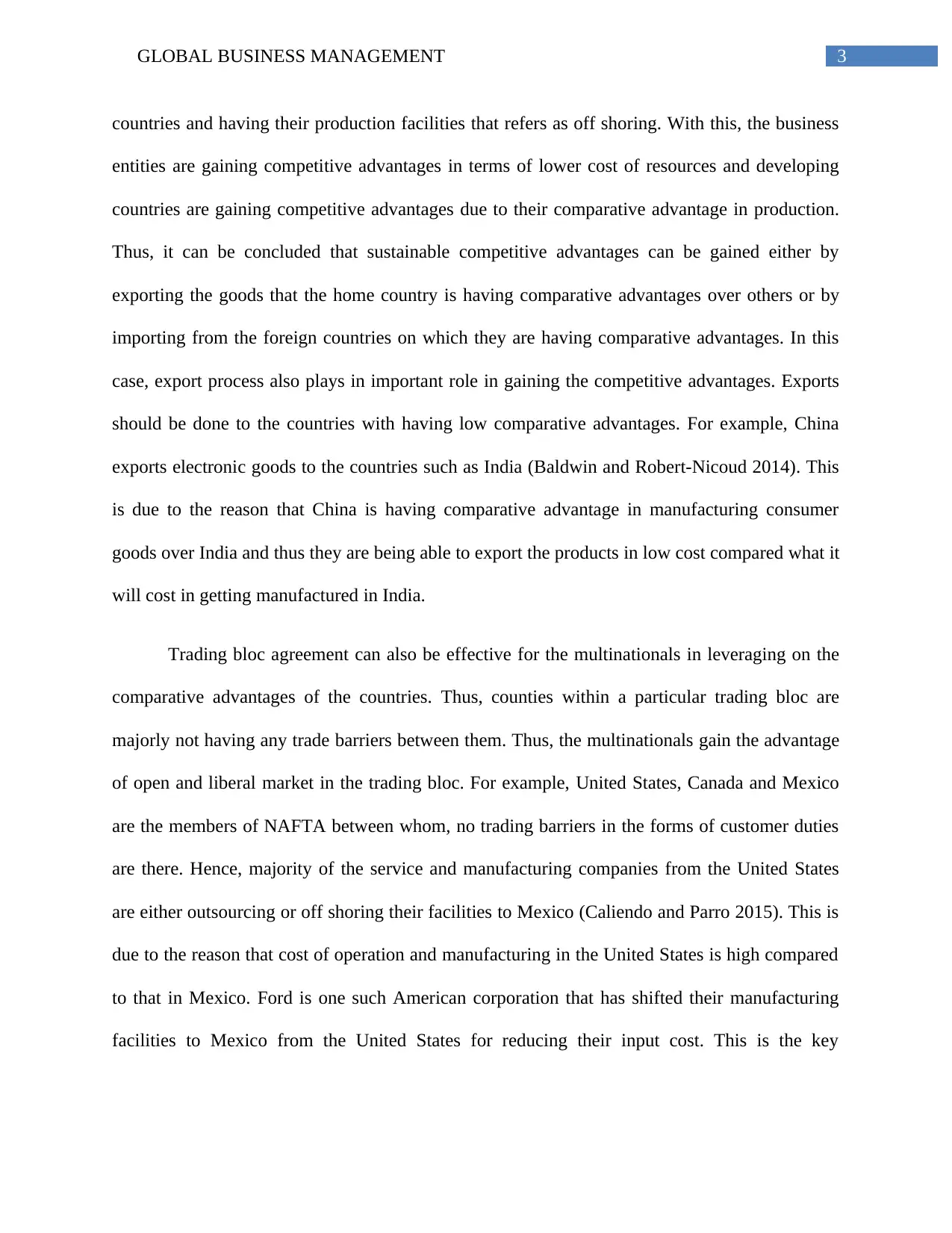
3GLOBAL BUSINESS MANAGEMENT
countries and having their production facilities that refers as off shoring. With this, the business
entities are gaining competitive advantages in terms of lower cost of resources and developing
countries are gaining competitive advantages due to their comparative advantage in production.
Thus, it can be concluded that sustainable competitive advantages can be gained either by
exporting the goods that the home country is having comparative advantages over others or by
importing from the foreign countries on which they are having comparative advantages. In this
case, export process also plays in important role in gaining the competitive advantages. Exports
should be done to the countries with having low comparative advantages. For example, China
exports electronic goods to the countries such as India (Baldwin and Robert-Nicoud 2014). This
is due to the reason that China is having comparative advantage in manufacturing consumer
goods over India and thus they are being able to export the products in low cost compared what it
will cost in getting manufactured in India.
Trading bloc agreement can also be effective for the multinationals in leveraging on the
comparative advantages of the countries. Thus, counties within a particular trading bloc are
majorly not having any trade barriers between them. Thus, the multinationals gain the advantage
of open and liberal market in the trading bloc. For example, United States, Canada and Mexico
are the members of NAFTA between whom, no trading barriers in the forms of customer duties
are there. Hence, majority of the service and manufacturing companies from the United States
are either outsourcing or off shoring their facilities to Mexico (Caliendo and Parro 2015). This is
due to the reason that cost of operation and manufacturing in the United States is high compared
to that in Mexico. Ford is one such American corporation that has shifted their manufacturing
facilities to Mexico from the United States for reducing their input cost. This is the key
countries and having their production facilities that refers as off shoring. With this, the business
entities are gaining competitive advantages in terms of lower cost of resources and developing
countries are gaining competitive advantages due to their comparative advantage in production.
Thus, it can be concluded that sustainable competitive advantages can be gained either by
exporting the goods that the home country is having comparative advantages over others or by
importing from the foreign countries on which they are having comparative advantages. In this
case, export process also plays in important role in gaining the competitive advantages. Exports
should be done to the countries with having low comparative advantages. For example, China
exports electronic goods to the countries such as India (Baldwin and Robert-Nicoud 2014). This
is due to the reason that China is having comparative advantage in manufacturing consumer
goods over India and thus they are being able to export the products in low cost compared what it
will cost in getting manufactured in India.
Trading bloc agreement can also be effective for the multinationals in leveraging on the
comparative advantages of the countries. Thus, counties within a particular trading bloc are
majorly not having any trade barriers between them. Thus, the multinationals gain the advantage
of open and liberal market in the trading bloc. For example, United States, Canada and Mexico
are the members of NAFTA between whom, no trading barriers in the forms of customer duties
are there. Hence, majority of the service and manufacturing companies from the United States
are either outsourcing or off shoring their facilities to Mexico (Caliendo and Parro 2015). This is
due to the reason that cost of operation and manufacturing in the United States is high compared
to that in Mexico. Ford is one such American corporation that has shifted their manufacturing
facilities to Mexico from the United States for reducing their input cost. This is the key
Paraphrase This Document
Need a fresh take? Get an instant paraphrase of this document with our AI Paraphraser
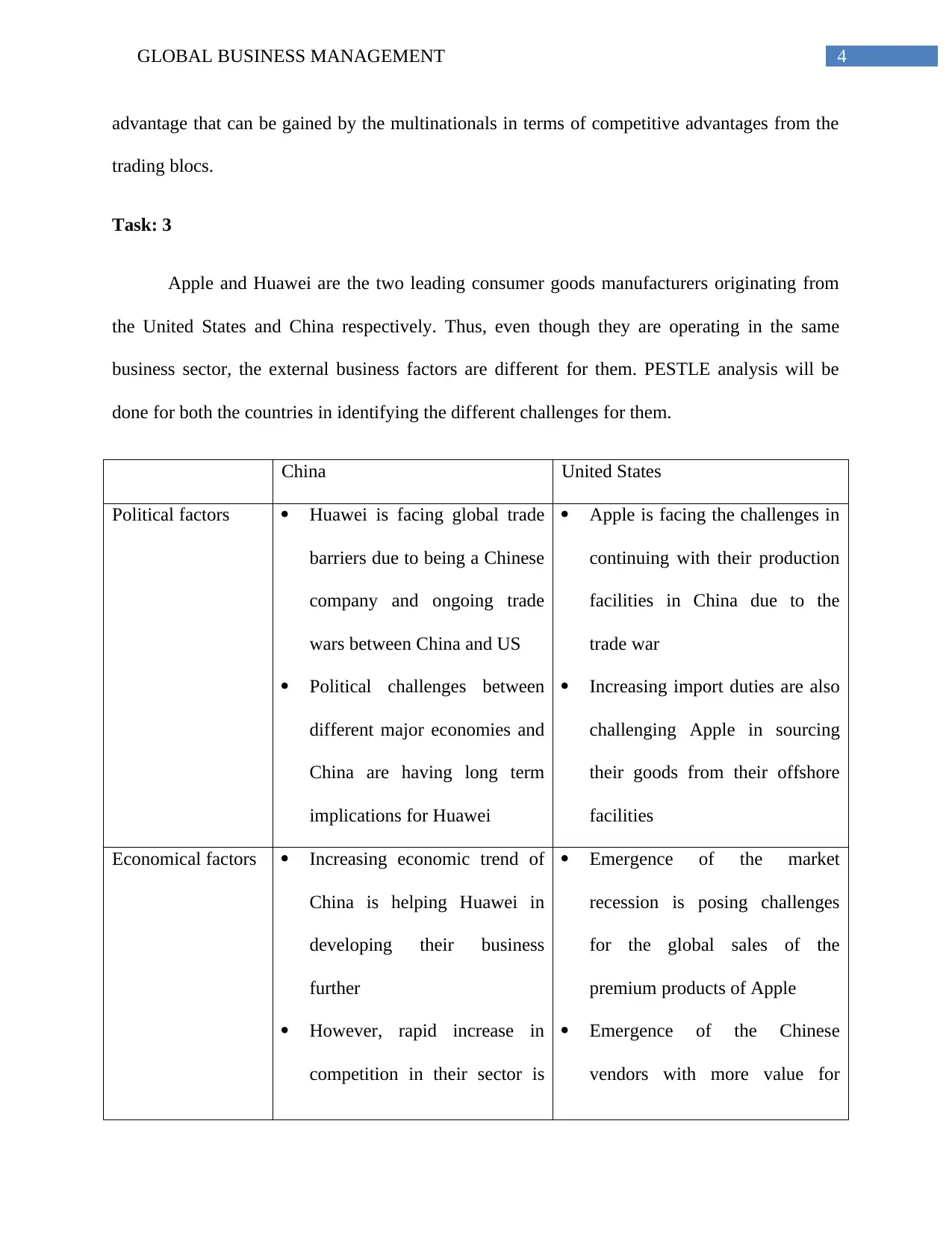
4GLOBAL BUSINESS MANAGEMENT
advantage that can be gained by the multinationals in terms of competitive advantages from the
trading blocs.
Task: 3
Apple and Huawei are the two leading consumer goods manufacturers originating from
the United States and China respectively. Thus, even though they are operating in the same
business sector, the external business factors are different for them. PESTLE analysis will be
done for both the countries in identifying the different challenges for them.
China United States
Political factors Huawei is facing global trade
barriers due to being a Chinese
company and ongoing trade
wars between China and US
Political challenges between
different major economies and
China are having long term
implications for Huawei
Apple is facing the challenges in
continuing with their production
facilities in China due to the
trade war
Increasing import duties are also
challenging Apple in sourcing
their goods from their offshore
facilities
Economical factors Increasing economic trend of
China is helping Huawei in
developing their business
further
However, rapid increase in
competition in their sector is
Emergence of the market
recession is posing challenges
for the global sales of the
premium products of Apple
Emergence of the Chinese
vendors with more value for
advantage that can be gained by the multinationals in terms of competitive advantages from the
trading blocs.
Task: 3
Apple and Huawei are the two leading consumer goods manufacturers originating from
the United States and China respectively. Thus, even though they are operating in the same
business sector, the external business factors are different for them. PESTLE analysis will be
done for both the countries in identifying the different challenges for them.
China United States
Political factors Huawei is facing global trade
barriers due to being a Chinese
company and ongoing trade
wars between China and US
Political challenges between
different major economies and
China are having long term
implications for Huawei
Apple is facing the challenges in
continuing with their production
facilities in China due to the
trade war
Increasing import duties are also
challenging Apple in sourcing
their goods from their offshore
facilities
Economical factors Increasing economic trend of
China is helping Huawei in
developing their business
further
However, rapid increase in
competition in their sector is
Emergence of the market
recession is posing challenges
for the global sales of the
premium products of Apple
Emergence of the Chinese
vendors with more value for
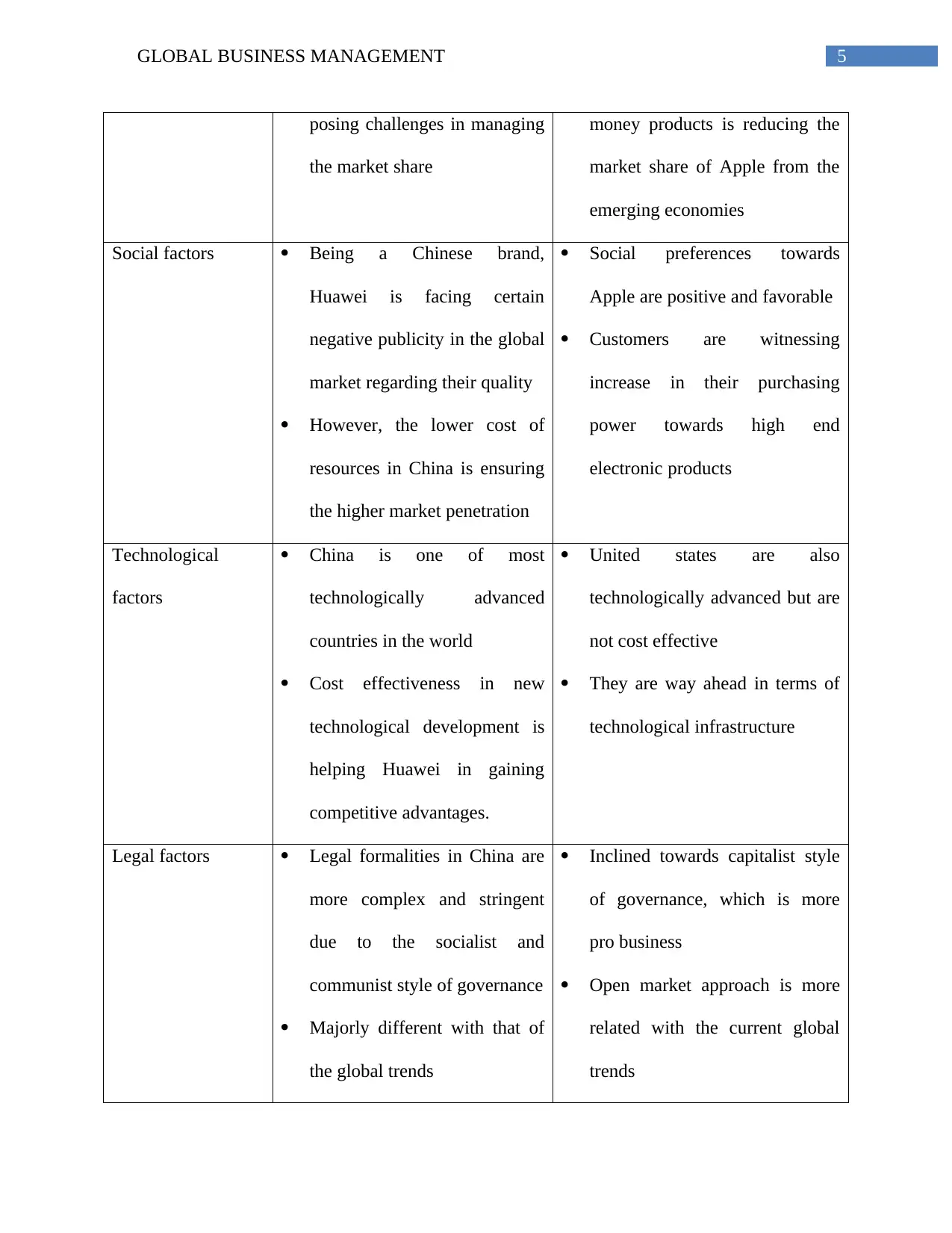
5GLOBAL BUSINESS MANAGEMENT
posing challenges in managing
the market share
money products is reducing the
market share of Apple from the
emerging economies
Social factors Being a Chinese brand,
Huawei is facing certain
negative publicity in the global
market regarding their quality
However, the lower cost of
resources in China is ensuring
the higher market penetration
Social preferences towards
Apple are positive and favorable
Customers are witnessing
increase in their purchasing
power towards high end
electronic products
Technological
factors
China is one of most
technologically advanced
countries in the world
Cost effectiveness in new
technological development is
helping Huawei in gaining
competitive advantages.
United states are also
technologically advanced but are
not cost effective
They are way ahead in terms of
technological infrastructure
Legal factors Legal formalities in China are
more complex and stringent
due to the socialist and
communist style of governance
Majorly different with that of
the global trends
Inclined towards capitalist style
of governance, which is more
pro business
Open market approach is more
related with the current global
trends
posing challenges in managing
the market share
money products is reducing the
market share of Apple from the
emerging economies
Social factors Being a Chinese brand,
Huawei is facing certain
negative publicity in the global
market regarding their quality
However, the lower cost of
resources in China is ensuring
the higher market penetration
Social preferences towards
Apple are positive and favorable
Customers are witnessing
increase in their purchasing
power towards high end
electronic products
Technological
factors
China is one of most
technologically advanced
countries in the world
Cost effectiveness in new
technological development is
helping Huawei in gaining
competitive advantages.
United states are also
technologically advanced but are
not cost effective
They are way ahead in terms of
technological infrastructure
Legal factors Legal formalities in China are
more complex and stringent
due to the socialist and
communist style of governance
Majorly different with that of
the global trends
Inclined towards capitalist style
of governance, which is more
pro business
Open market approach is more
related with the current global
trends
You're viewing a preview
Unlock full access by subscribing today!
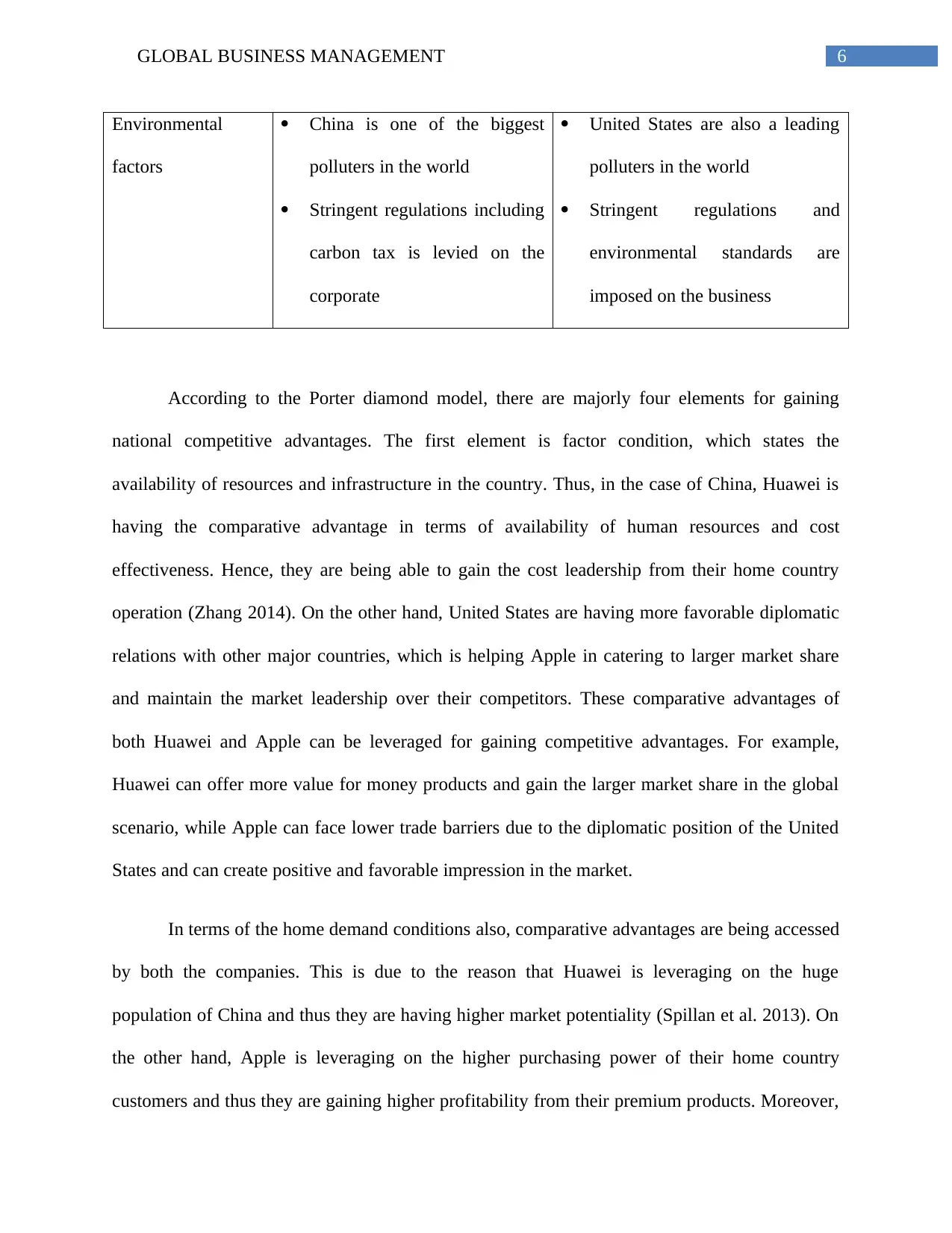
6GLOBAL BUSINESS MANAGEMENT
Environmental
factors
China is one of the biggest
polluters in the world
Stringent regulations including
carbon tax is levied on the
corporate
United States are also a leading
polluters in the world
Stringent regulations and
environmental standards are
imposed on the business
According to the Porter diamond model, there are majorly four elements for gaining
national competitive advantages. The first element is factor condition, which states the
availability of resources and infrastructure in the country. Thus, in the case of China, Huawei is
having the comparative advantage in terms of availability of human resources and cost
effectiveness. Hence, they are being able to gain the cost leadership from their home country
operation (Zhang 2014). On the other hand, United States are having more favorable diplomatic
relations with other major countries, which is helping Apple in catering to larger market share
and maintain the market leadership over their competitors. These comparative advantages of
both Huawei and Apple can be leveraged for gaining competitive advantages. For example,
Huawei can offer more value for money products and gain the larger market share in the global
scenario, while Apple can face lower trade barriers due to the diplomatic position of the United
States and can create positive and favorable impression in the market.
In terms of the home demand conditions also, comparative advantages are being accessed
by both the companies. This is due to the reason that Huawei is leveraging on the huge
population of China and thus they are having higher market potentiality (Spillan et al. 2013). On
the other hand, Apple is leveraging on the higher purchasing power of their home country
customers and thus they are gaining higher profitability from their premium products. Moreover,
Environmental
factors
China is one of the biggest
polluters in the world
Stringent regulations including
carbon tax is levied on the
corporate
United States are also a leading
polluters in the world
Stringent regulations and
environmental standards are
imposed on the business
According to the Porter diamond model, there are majorly four elements for gaining
national competitive advantages. The first element is factor condition, which states the
availability of resources and infrastructure in the country. Thus, in the case of China, Huawei is
having the comparative advantage in terms of availability of human resources and cost
effectiveness. Hence, they are being able to gain the cost leadership from their home country
operation (Zhang 2014). On the other hand, United States are having more favorable diplomatic
relations with other major countries, which is helping Apple in catering to larger market share
and maintain the market leadership over their competitors. These comparative advantages of
both Huawei and Apple can be leveraged for gaining competitive advantages. For example,
Huawei can offer more value for money products and gain the larger market share in the global
scenario, while Apple can face lower trade barriers due to the diplomatic position of the United
States and can create positive and favorable impression in the market.
In terms of the home demand conditions also, comparative advantages are being accessed
by both the companies. This is due to the reason that Huawei is leveraging on the huge
population of China and thus they are having higher market potentiality (Spillan et al. 2013). On
the other hand, Apple is leveraging on the higher purchasing power of their home country
customers and thus they are gaining higher profitability from their premium products. Moreover,
Paraphrase This Document
Need a fresh take? Get an instant paraphrase of this document with our AI Paraphraser
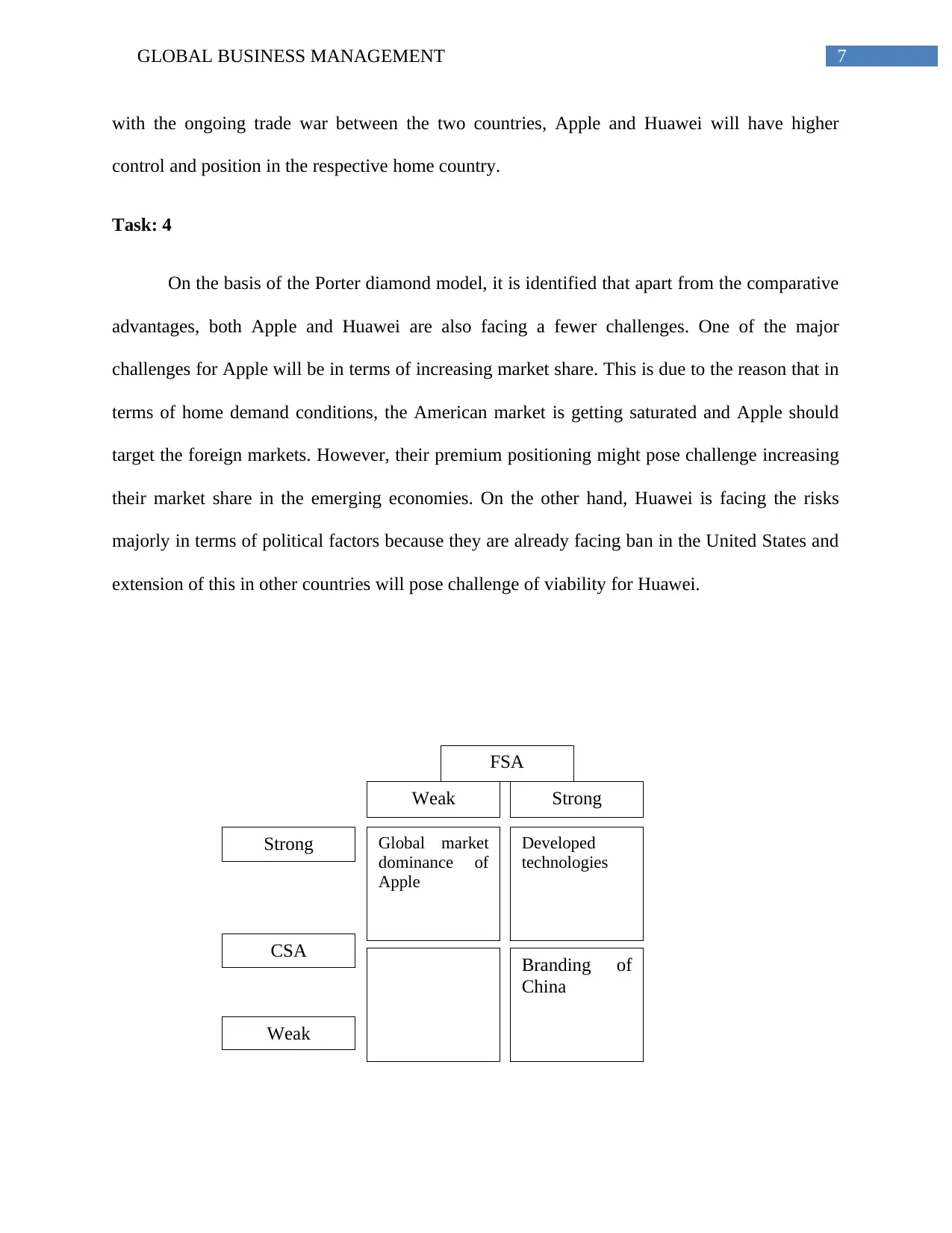
7GLOBAL BUSINESS MANAGEMENT
Global market
dominance of
Apple
Branding of
China
Developed
technologies
FSA
CSA
Weak Strong
Weak
Strong
with the ongoing trade war between the two countries, Apple and Huawei will have higher
control and position in the respective home country.
Task: 4
On the basis of the Porter diamond model, it is identified that apart from the comparative
advantages, both Apple and Huawei are also facing a fewer challenges. One of the major
challenges for Apple will be in terms of increasing market share. This is due to the reason that in
terms of home demand conditions, the American market is getting saturated and Apple should
target the foreign markets. However, their premium positioning might pose challenge increasing
their market share in the emerging economies. On the other hand, Huawei is facing the risks
majorly in terms of political factors because they are already facing ban in the United States and
extension of this in other countries will pose challenge of viability for Huawei.
Global market
dominance of
Apple
Branding of
China
Developed
technologies
FSA
CSA
Weak Strong
Weak
Strong
with the ongoing trade war between the two countries, Apple and Huawei will have higher
control and position in the respective home country.
Task: 4
On the basis of the Porter diamond model, it is identified that apart from the comparative
advantages, both Apple and Huawei are also facing a fewer challenges. One of the major
challenges for Apple will be in terms of increasing market share. This is due to the reason that in
terms of home demand conditions, the American market is getting saturated and Apple should
target the foreign markets. However, their premium positioning might pose challenge increasing
their market share in the emerging economies. On the other hand, Huawei is facing the risks
majorly in terms of political factors because they are already facing ban in the United States and
extension of this in other countries will pose challenge of viability for Huawei.
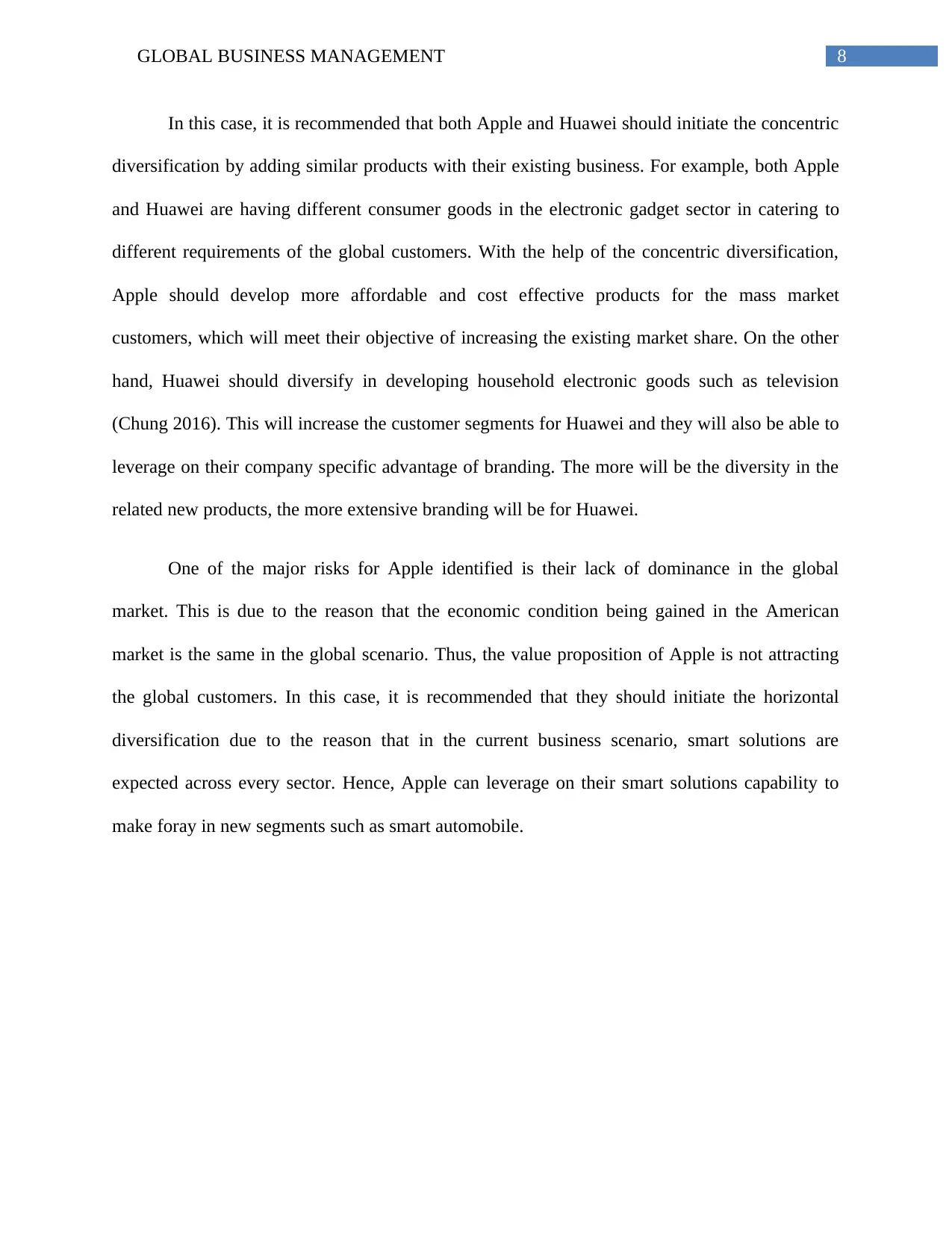
8GLOBAL BUSINESS MANAGEMENT
In this case, it is recommended that both Apple and Huawei should initiate the concentric
diversification by adding similar products with their existing business. For example, both Apple
and Huawei are having different consumer goods in the electronic gadget sector in catering to
different requirements of the global customers. With the help of the concentric diversification,
Apple should develop more affordable and cost effective products for the mass market
customers, which will meet their objective of increasing the existing market share. On the other
hand, Huawei should diversify in developing household electronic goods such as television
(Chung 2016). This will increase the customer segments for Huawei and they will also be able to
leverage on their company specific advantage of branding. The more will be the diversity in the
related new products, the more extensive branding will be for Huawei.
One of the major risks for Apple identified is their lack of dominance in the global
market. This is due to the reason that the economic condition being gained in the American
market is the same in the global scenario. Thus, the value proposition of Apple is not attracting
the global customers. In this case, it is recommended that they should initiate the horizontal
diversification due to the reason that in the current business scenario, smart solutions are
expected across every sector. Hence, Apple can leverage on their smart solutions capability to
make foray in new segments such as smart automobile.
In this case, it is recommended that both Apple and Huawei should initiate the concentric
diversification by adding similar products with their existing business. For example, both Apple
and Huawei are having different consumer goods in the electronic gadget sector in catering to
different requirements of the global customers. With the help of the concentric diversification,
Apple should develop more affordable and cost effective products for the mass market
customers, which will meet their objective of increasing the existing market share. On the other
hand, Huawei should diversify in developing household electronic goods such as television
(Chung 2016). This will increase the customer segments for Huawei and they will also be able to
leverage on their company specific advantage of branding. The more will be the diversity in the
related new products, the more extensive branding will be for Huawei.
One of the major risks for Apple identified is their lack of dominance in the global
market. This is due to the reason that the economic condition being gained in the American
market is the same in the global scenario. Thus, the value proposition of Apple is not attracting
the global customers. In this case, it is recommended that they should initiate the horizontal
diversification due to the reason that in the current business scenario, smart solutions are
expected across every sector. Hence, Apple can leverage on their smart solutions capability to
make foray in new segments such as smart automobile.
You're viewing a preview
Unlock full access by subscribing today!
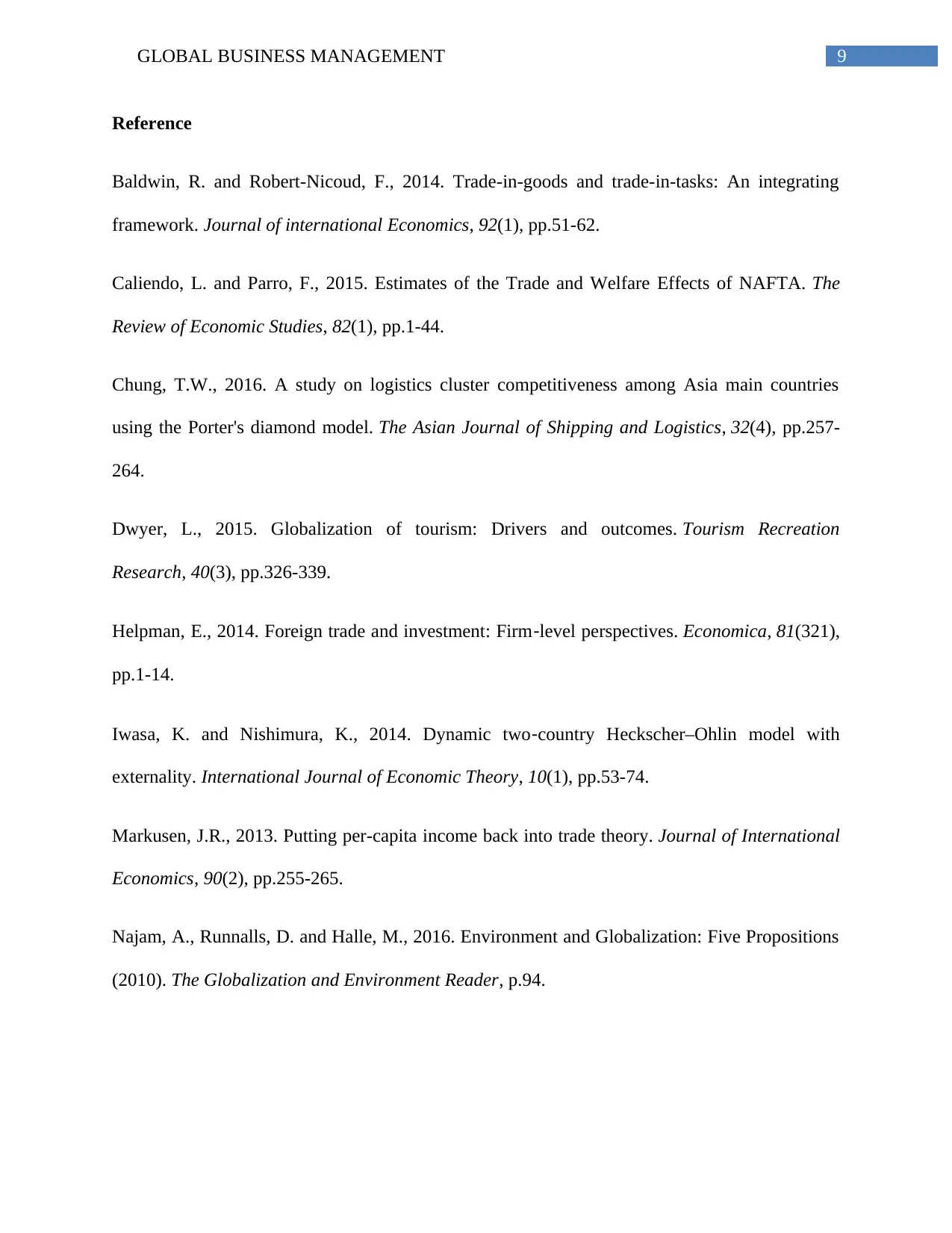
9GLOBAL BUSINESS MANAGEMENT
Reference
Baldwin, R. and Robert-Nicoud, F., 2014. Trade-in-goods and trade-in-tasks: An integrating
framework. Journal of international Economics, 92(1), pp.51-62.
Caliendo, L. and Parro, F., 2015. Estimates of the Trade and Welfare Effects of NAFTA. The
Review of Economic Studies, 82(1), pp.1-44.
Chung, T.W., 2016. A study on logistics cluster competitiveness among Asia main countries
using the Porter's diamond model. The Asian Journal of Shipping and Logistics, 32(4), pp.257-
264.
Dwyer, L., 2015. Globalization of tourism: Drivers and outcomes. Tourism Recreation
Research, 40(3), pp.326-339.
Helpman, E., 2014. Foreign trade and investment: Firm‐level perspectives. Economica, 81(321),
pp.1-14.
Iwasa, K. and Nishimura, K., 2014. Dynamic two‐country Heckscher–Ohlin model with
externality. International Journal of Economic Theory, 10(1), pp.53-74.
Markusen, J.R., 2013. Putting per-capita income back into trade theory. Journal of International
Economics, 90(2), pp.255-265.
Najam, A., Runnalls, D. and Halle, M., 2016. Environment and Globalization: Five Propositions
(2010). The Globalization and Environment Reader, p.94.
Reference
Baldwin, R. and Robert-Nicoud, F., 2014. Trade-in-goods and trade-in-tasks: An integrating
framework. Journal of international Economics, 92(1), pp.51-62.
Caliendo, L. and Parro, F., 2015. Estimates of the Trade and Welfare Effects of NAFTA. The
Review of Economic Studies, 82(1), pp.1-44.
Chung, T.W., 2016. A study on logistics cluster competitiveness among Asia main countries
using the Porter's diamond model. The Asian Journal of Shipping and Logistics, 32(4), pp.257-
264.
Dwyer, L., 2015. Globalization of tourism: Drivers and outcomes. Tourism Recreation
Research, 40(3), pp.326-339.
Helpman, E., 2014. Foreign trade and investment: Firm‐level perspectives. Economica, 81(321),
pp.1-14.
Iwasa, K. and Nishimura, K., 2014. Dynamic two‐country Heckscher–Ohlin model with
externality. International Journal of Economic Theory, 10(1), pp.53-74.
Markusen, J.R., 2013. Putting per-capita income back into trade theory. Journal of International
Economics, 90(2), pp.255-265.
Najam, A., Runnalls, D. and Halle, M., 2016. Environment and Globalization: Five Propositions
(2010). The Globalization and Environment Reader, p.94.
Paraphrase This Document
Need a fresh take? Get an instant paraphrase of this document with our AI Paraphraser
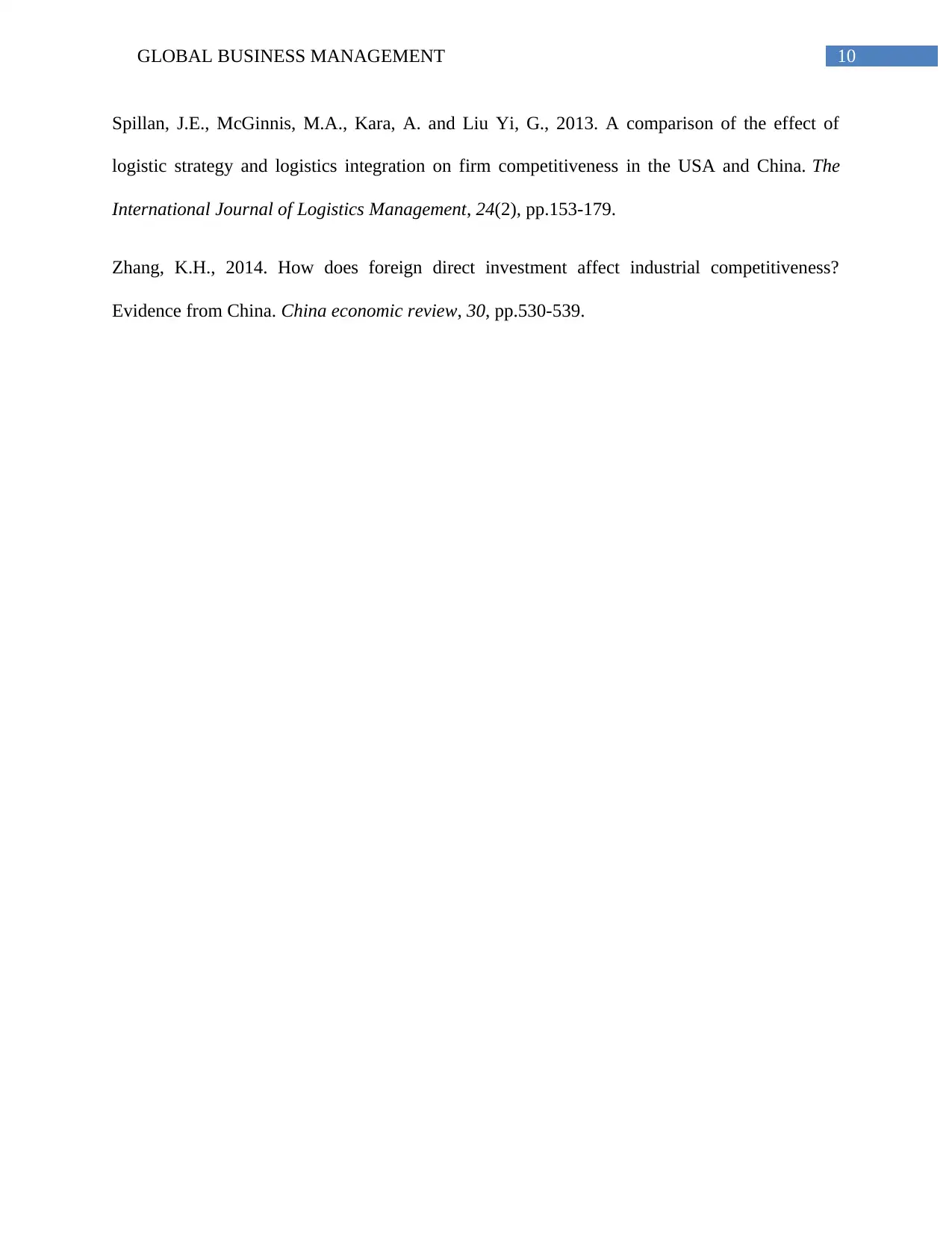
10GLOBAL BUSINESS MANAGEMENT
Spillan, J.E., McGinnis, M.A., Kara, A. and Liu Yi, G., 2013. A comparison of the effect of
logistic strategy and logistics integration on firm competitiveness in the USA and China. The
International Journal of Logistics Management, 24(2), pp.153-179.
Zhang, K.H., 2014. How does foreign direct investment affect industrial competitiveness?
Evidence from China. China economic review, 30, pp.530-539.
Spillan, J.E., McGinnis, M.A., Kara, A. and Liu Yi, G., 2013. A comparison of the effect of
logistic strategy and logistics integration on firm competitiveness in the USA and China. The
International Journal of Logistics Management, 24(2), pp.153-179.
Zhang, K.H., 2014. How does foreign direct investment affect industrial competitiveness?
Evidence from China. China economic review, 30, pp.530-539.
1 out of 11
Related Documents
Your All-in-One AI-Powered Toolkit for Academic Success.
+13062052269
info@desklib.com
Available 24*7 on WhatsApp / Email
![[object Object]](/_next/static/media/star-bottom.7253800d.svg)
Unlock your academic potential
© 2024 | Zucol Services PVT LTD | All rights reserved.




